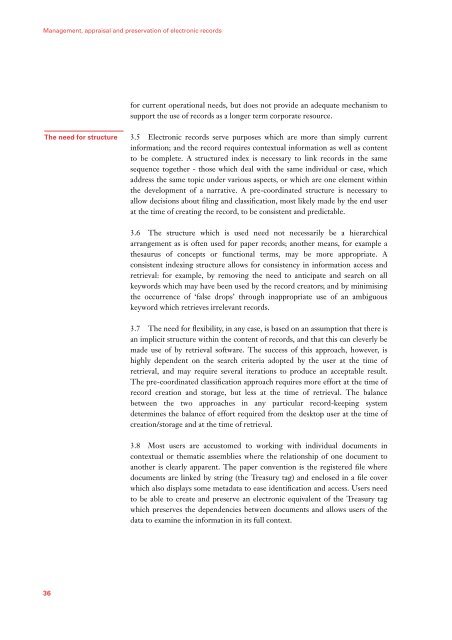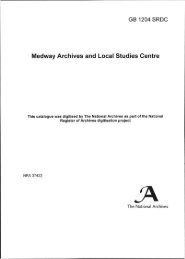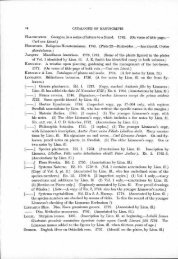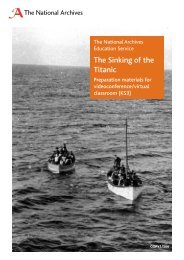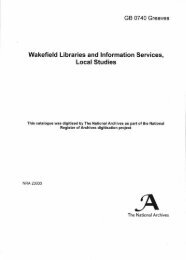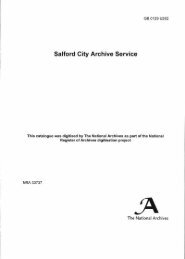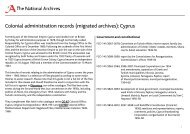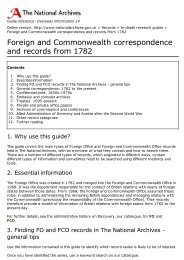Management, appraisal and preservation of electronic records: Vol 1 ...
Management, appraisal and preservation of electronic records: Vol 1 ...
Management, appraisal and preservation of electronic records: Vol 1 ...
You also want an ePaper? Increase the reach of your titles
YUMPU automatically turns print PDFs into web optimized ePapers that Google loves.
<strong>Management</strong>, <strong>appraisal</strong> <strong>and</strong> <strong>preservation</strong> <strong>of</strong> <strong>electronic</strong> <strong>records</strong><br />
The need for structure<br />
36<br />
for current operational needs, but does not provide an adequate mechanism to<br />
support the use <strong>of</strong> <strong>records</strong> as a longer term corporate resource.<br />
3.5 Electronic <strong>records</strong> serve purposes which are more than simply current<br />
information; <strong>and</strong> the record requires contextual information as well as content<br />
to be complete. A structured index is necessary to link <strong>records</strong> in the same<br />
sequence together - those which deal with the same individual or case, which<br />
address the same topic under various aspects, or which are one element within<br />
the development <strong>of</strong> a narrative. A pre-coordinated structure is necessary to<br />
allow decisions about filing <strong>and</strong> classification, most likely made by the end user<br />
at the time <strong>of</strong> creating the record, to be consistent <strong>and</strong> predictable.<br />
3.6 The structure which is used need not necessarily be a hierarchical<br />
arrangement as is <strong>of</strong>ten used for paper <strong>records</strong>; another means, for example a<br />
thesaurus <strong>of</strong> concepts or functional terms, may be more appropriate. A<br />
consistent indexing structure allows for consistency in information access <strong>and</strong><br />
retrieval: for example, by removing the need to anticipate <strong>and</strong> search on all<br />
keywords which may have been used by the record creators; <strong>and</strong> by minimising<br />
the occurrence <strong>of</strong> ‘false drops’ through inappropriate use <strong>of</strong> an ambiguous<br />
keyword which retrieves irrelevant <strong>records</strong>.<br />
3.7 The need for flexibility, in any case, is based on an assumption that there is<br />
an implicit structure within the content <strong>of</strong> <strong>records</strong>, <strong>and</strong> that this can cleverly be<br />
made use <strong>of</strong> by retrieval s<strong>of</strong>tware. The success <strong>of</strong> this approach, however, is<br />
highly dependent on the search criteria adopted by the user at the time <strong>of</strong><br />
retrieval, <strong>and</strong> may require several iterations to produce an acceptable result.<br />
The pre-coordinated classification approach requires more effort at the time <strong>of</strong><br />
record creation <strong>and</strong> storage, but less at the time <strong>of</strong> retrieval. The balance<br />
between the two approaches in any particular record-keeping system<br />
determines the balance <strong>of</strong> effort required from the desktop user at the time <strong>of</strong><br />
creation/storage <strong>and</strong> at the time <strong>of</strong> retrieval.<br />
3.8 Most users are accustomed to working with individual documents in<br />
contextual or thematic assemblies where the relationship <strong>of</strong> one document to<br />
another is clearly apparent. The paper convention is the registered file where<br />
documents are linked by string (the Treasury tag) <strong>and</strong> enclosed in a file cover<br />
which also displays some metadata to ease identification <strong>and</strong> access. Users need<br />
to be able to create <strong>and</strong> preserve an <strong>electronic</strong> equivalent <strong>of</strong> the Treasury tag<br />
which preserves the dependencies between documents <strong>and</strong> allows users <strong>of</strong> the<br />
data to examine the information in its full context.


